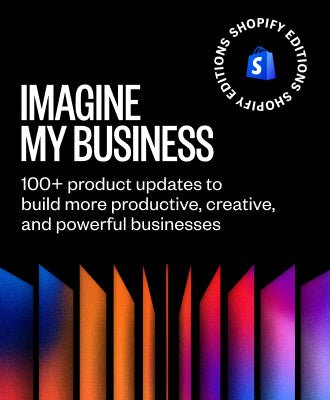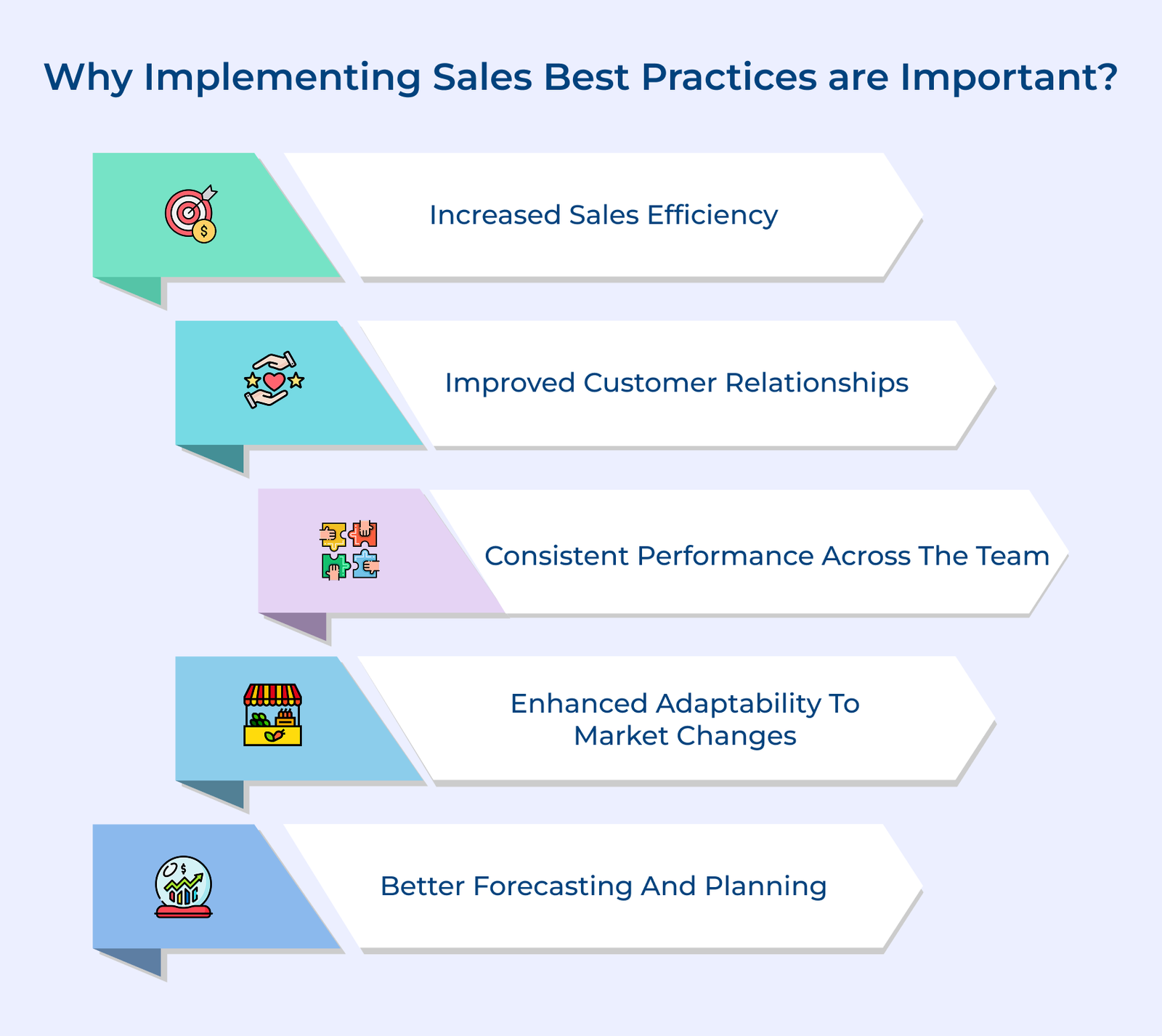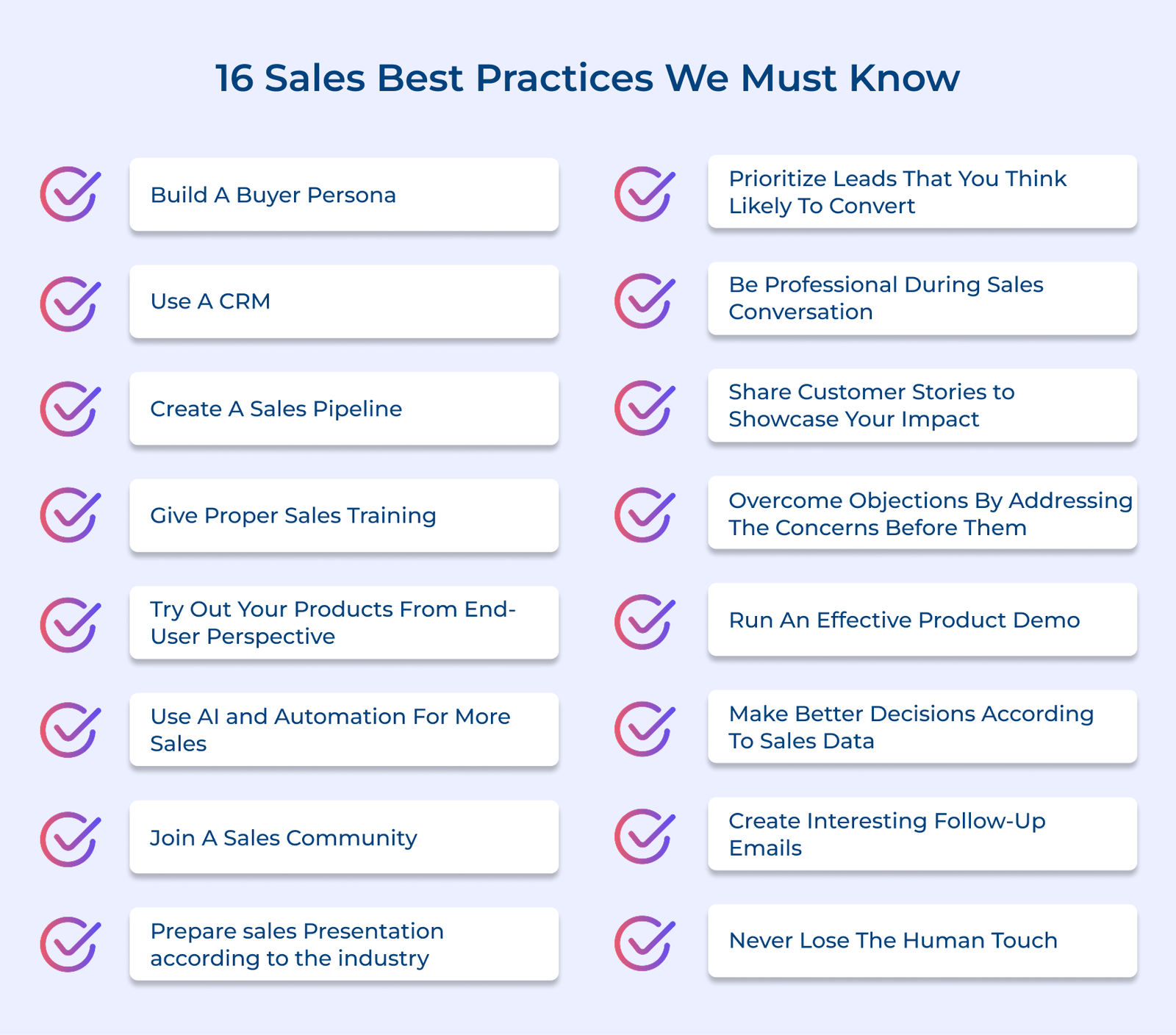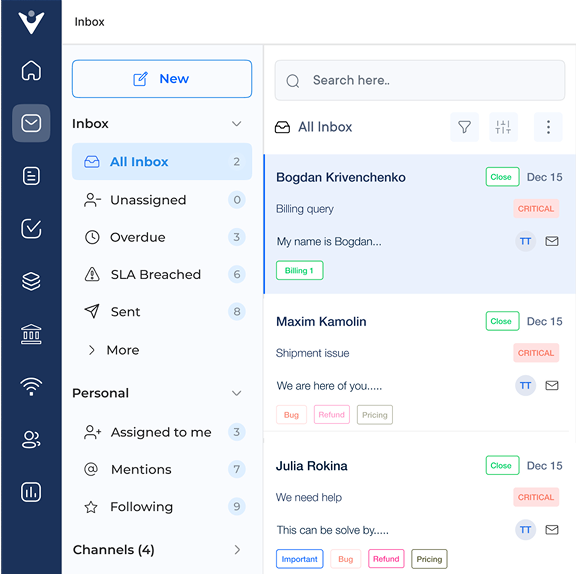1. Build a Buyer Persona
A buyer persona is a semi-fictional depiction of your ideal customer, crafted from market research and real data. It encompasses demographics, behavior patterns, motivations and goals, helping sales teams better understand their target audience. 56% of companies generated higher-quality leads using buyer personas.
Creating detailed buyer personas is vital for an effective sales strategy. They enable salespeople to tailor their messaging to specific customer types, enhancing more meaningful interactions and leading to higher conversion rates.
Actionable tips:
- Conduct in-depth interviews with your top customers to gather valuable qualitative insights for your personas.
- Enhance the data by leveraging tools like Google Analytics and social media insights for a robust quantitative foundation.
2. Use A CRM (Customer Relationship Management Software)
A CRM system is an essential tool for businesses to manage interactions with current and potential customers. CRMs provide valuable insights that enhance sales processes by centralizing customer data and tracking sales activities. Key benefits of using a CRM include better organization of customer information, streamlined sales pipeline tracking, improved team collaboration and data-driven decision-making.
CRMs boost sales efficiency by automating routine tasks, giving quick access to customer information and facilitating timely follow-ups. They also strengthen customer relationships by ensuring consistent communication and enabling personalized interactions based on the customer’s history with your business.
Actionable tips:
- Dedicate time to thoroughly train your team on using the CRM to ensure full adoption and optimal performance.
- Regularly clean and update your CRM data to keep it accurate.
3. Create a Sales Pipeline
A sales pipeline visually tracks where prospects are in the buying process, enabling sales teams to manage deals effectively. A well-defined pipeline clarifies the sales process, identifies bottlenecks and enhances forecasting accuracy.
Key stages typically include prospecting, qualification, proposal, negotiation and closure, each with clear definitions for advancing deals. The structured approach empowers salespeople to know exactly what actions to take at every stage.
Actionable tips:
- Leverage visual tools like flowcharts or CRM dashboards to simplify your sales pipeline, making it clear and easy to follow.
- Conduct regular pipeline review meetings to ensure everyone is using the system consistently and to address any issues.
4. Give Proper Sales Training
Continuous sales training is vital for sustaining a high-performing team. It sharpens skills, introduces fresh techniques and helps salespeople adapt to market changes. Regular training also enhances morale and reduces turnover by demonstrating a commitment to employee growth.
Focus on key areas such as product knowledge, prospecting, objection handling, closing strategies and sales tools. Don’t forget to emphasize soft skills like active listening, empathy and adaptability. Look at metrics like conversion rates, average deal size and time to close.
Pro tips:
- Incorporate diverse training methods like role-playing, e-learning and peer mentoring.
- Enhance a culture of continuous learning by dedicating time each week for skill development and knowledge sharing.
5. Use Your Products From End-User Perspective
Experiencing your products as an end user helps you pinpoint strengths, weaknesses and unique selling points that marketing materials may overlook. Immerse yourself in real-world scenarios that reflect your customers’ environments to conduct effective product testing. Pay attention to the onboarding process, user interface, features and any challenges you face.
Use your product experience in sales conversations by sharing relatable examples and anecdotes. Firsthand knowledge not only boosts your confidence but also allows you to provide authentic recommendations. Highlight your insights to tackle common pain points and showcase features that genuinely enhance the customer’s workflow.
Pro tips:
- Host regular “product immersion days” for your sales team to use the product extensively and share their insights.
- Establish a feedback loop between sales and product development to exchange valuable experiences from firsthand use.
6. Use AI and Automation For More Sales
AI and automation are transforming sales processes, enabling teams to operate more efficiently. The technologies free salespeople to focus on high-value activities that require creativity by managing routine tasks. Businesses can expect a 6–10% increase in revenue by adopting artificial Intelligence tools and solutions.
Striking a balance between automation and personalization is crucial. Use the tools to enhance human capabilities, ensuring that automated communications remain personal and relevant to each customer.
Actionable tips:
- Launch a pilot program to introduce AI or automation in a specific area of your sales process, then expand based on the results.
- Regularly evaluate and refine these systems to ensure they deliver value without causing friction in your sales workflow.
7. Join a Sales Community
Joining sales communities brings a wealth of benefits, from industry insights and peer support to opportunities for professional growth. The platforms allow members to share best practices, discuss challenges and stay updated on trends.
Sales communities exist both online and offline. Online options include professional social media groups, forums and dedicated sales platforms, while offline opportunities include local networking events, industry conferences or professional associations.
Actionable tips:
- Allocate time each week to connect with your chosen sales communities, both online and offline.
- After participating in events or discussions, capture key takeaways and create an action plan to integrate valuable insights into your sales strategy.
8. Prepare a Sales Presentation According To Prospect’s Industry
Industry-specific sales presentations highlight your understanding of a prospect’s unique challenges, demonstrating that you’ve done your homework and genuinely want to add value. Research your prospect’s sector through industry reports, trade publications and their company website to gather industry insights, focusing on current trends.
When customizing your presentation, adjust your content, language and examples to fit the prospect’s industry. Incorporate relevant case studies, statistics and terminology that resonate with their context. Tailor your value proposition to address their specific pain points and goals.
Actionable tips:
- Build a library of industry-specific content, including case studies, statistics and common challenges, for easy integration into your presentations.
- Before each meeting, dedicate at least 30 minutes to researching the prospect’s company and recent industry news, ensuring you can share timely, relevant insights.
9. Prioritize Leads That You Think Likely To Convert
Lead scoring and prioritization are essential for enhancing sales efficiency. Sales teams can optimize their time and resources by concentrating on high-potential leads, resulting in higher conversion rates.
Assess factors like demographic fit, engagement level, budget, authority, need and timeline (BANT criteria). Also, track behavioral signals such as website visits, content downloads and email interactions. Create a scoring system that weights the elements according to their significance in your sales process.
Actionable tips:
- Set up a lead scoring system in your CRM and continuously refine it using actual conversion data.
- Equip your team with a standardized set of qualifying questions that align with your prioritization criteria for quick and effective lead assessment.
10. Be Professional During Sales Conversation
Professionalism in sales conversations is vital for establishing trust and credibility with prospects. Components include being well-prepared, respecting the prospect’s time and maintaining a positive, solution-oriented attitude. Address concerns objectively and focus on finding mutually beneficial solutions, avoiding defensiveness or arguments that could harm the relationship.
Building trust through professionalism means consistency in words and actions. Follow through on commitments, be transparent about your product’s capabilities and always prioritize the customer’s best interests. The approach fosters long-term relationships and encourages repeat business.
Actionable tips:
- Develop a pre-call checklist to ensure you’re always well-prepared for sales conversations.
- Practice active listening techniques, such as summarizing and asking clarifying questions, to improve your communication skills.
11. Share Customer Stories to Showcase Your Impact
Storytelling is a powerful sales tool that allows prospects to see your product’s benefits in a relatable way. Customer stories provide social proof and highlight real-world value, making your pitch more compelling. Regularly reach out to satisfied clients for testimonials or case studies, focusing on quantifiable results they faced.
Customer stories can also effectively address objections. Let’s assume that if a prospect worries about implementation time, share a success story of a client who had a smooth and quick setup. The proactive approach alleviates concerns and boosts confidence in your solution.
Actionable tips:
- Establish a streamlined process for gathering customer success stories, incorporating regular check-ins with clients and a standardized format for documenting outcomes.
- Create a searchable database to categorize the stories by industry, challenges addressed and results achieved, ensuring easy access during sales conversations.
12. Overcome Objections By Addressing The Concerns Before Them
Sales objections often arise from concerns about price, need, trust or timing. You can keep the sales conversation flowing and show you understand your prospect’s worries by anticipating these objections. Create an objection response playbook to ensure consistent and effective handling of common concerns.
Training your team in effective objection handling is essential. Incorporate role-playing exercises, analyze past objections and teach them to read subtle cues that may indicate unspoken concerns. Enhance a mindset that views objections as opportunities to clarify and build trust.
Actionable tips:
- Hold regular team sessions to review recent objections and collaboratively craft effective responses.
- Integrate objection-handling scenarios into your CRM or sales enablement platform for quick access during client interactions.
13. Run An Effective Product Demo
A compelling product demonstration highlights how your solution meets the prospect’s specific needs and pain points. Key elements include a clear structure, focus on relevant features and interactive components that engage the prospect. During the demo, treat questions and objections as opportunities to showcase your product’s strengths.
Follow up promptly after the demo, ideally within 24 hours by summarizing key points, addressing any lingering questions and outlining the next steps. It keeps the momentum going and reinforces the prospect’s interest.
Actionable tips
- Develop a demo checklist that includes technical setup, key points to cover and common questions to prepare for.
- Create a library of demo scenarios tailored to different industries and use cases for quick customization.
14. Make Better Decisions According To Sales Data
Key sales metrics to track include conversion rates at each sales funnel stage, average deal size, sales cycle length and customer acquisition cost. The insights reveal the effectiveness of your sales process and highlight areas for improvement. Utilize tools ranging from CRM reporting features to specialized business intelligence platforms.
Regularly review the metrics to identify trends and make informed decisions. Let’s consider that if certain lead types show higher conversion rates, adjust your targeting and prioritization strategies.
Actionable tips:
- Hold a weekly data review meeting where team members share key metrics and insights from their analyses.
- Adopt a data-driven approach to goal setting, using historical performance and market trends to inform sales targets.
15. Create Interesting Follow-Up Emails
Effective follow-up is crucial for closing deals, keeping your offering top-of-mind and showcasing your commitment to prospects. Craft engaging email subject lines and content to ensure your messages are opened and read. Sending your first follow-up has been shown to increase the reply rate by 49%.
Timing matters, too. Aim to send your first follow-up within 24 hours of initial contact, then space out subsequent follow-ups to maintain consistent engagement without being pushy. Monitor engagement metrics to fine-tune your timing for maximum impact.
Actionable tips:
- Build a library of follow-up email templates with customizable sections for effortless personalization.
- Utilize email tracking tools to monitor open rates and engagement, allowing you to refine your follow-up strategy based on real-time data.
16. Never Lose The Human Touch
While automation boosts efficiency, the human touch is crucial for building trust and understanding customer needs. Use tech to enhance, not replace, meaningful connections. Genuine relationships stem from a true interest in your customer’s success, not just closing deals.
Maintaining that human element can be tricky but vital in digital sales. Opt for video calls to add a personal touch and in emails, use a conversational tone with personal touches that go beyond automated responses.
Actionable tips:
- Schedule regular check-ins with key customers to discuss their overarching business goals, not just your product.
- Implement a “personal touch” policy where every salesperson adds a unique, personalized element to each significant customer interaction.
Sales Best Practices Examples for Success
Following are the real-life examples of a brand that has not only recognized the importance of sales best practices but also embraced them wholeheartedly.
1. Amazon – Personalized Recommendations
Amazon has expertly harnessed AI and automation to elevate the customer experience, particularly through its recommendation engine. Amazon creates a personalized shopping journey by suggesting products based on browsing and purchase history.
Impact: The tailored approach has significantly boosted sales, with reports indicating that up to 35% of Amazon’s revenue stems from the recommendations. It enhances customer satisfaction by making the shopping experience more convenient and relevant.
2. Apple – Product Demos and In-Store Experience
Apple has mastered the art of effective product demonstrations by designing stores that encourage hands-on interaction. Customers can explore products freely, with knowledgeable staff on hand to provide demos and answer questions.
Impact: The strategy has enhanced exceptional customer loyalty and led to impressive sales figures, with Apple stores boasting the highest sales per square foot of any retailer in the U.S. The immersive experience also reinforces Apple’s premium pricing strategy, justifying the investment in their products.
3. Nike – Building a Community
Nike has embraced the sales best practice of community engagement by creating platforms like the Nike+ app and Run Club. The initiatives foster a vibrant community where customers can share experiences, set goals and interact with the brand regularly.
Impact: The strategy has strengthened customer loyalty and boosted lifetime value. As a result, Nike’s digital sales surged, making up approximately 35% of their total revenue by 2021.
4. Coca-Cola – Storytelling and Emotional Branding
Coca-Cola excels at leveraging customer stories through emotionally resonant advertising campaigns that position its consumers as heroes.
Impact: The strategy has solidified Coca-Cola’s status as one of the world’s most valuable and recognizable brands. Their focus on emotional branding enhances strong customer loyalty and sustains sales, even in markets where sugary drink consumption is on the decline.
5. Netflix – Data-Driven Decision Making
Netflix embodies the sales best practice of data-driven decision-making by utilizing viewer analytics to shape both recommendations and content creation.
Impact: The approach has enabled Netflix to produce highly targeted content that resonates with its audience, fueling growth to over 230 million subscribers worldwide as of 2023 and helping maintain a lower churn rate than industry averages.
Master the Art of Selling with Our Sales Best Practices
Mastering sales best practices is crucial. The proven strategies empower salespeople to achieve superior results, adapt to market shifts and cultivate lasting customer relationships. They offer a structured approach to optimizing every stage of the sales process from lead generation to closing deals and nurturing loyalty.
Key takeaways:
- Embracing continuous learning and adapting the best sales practices is key to long-term success.
- Data-driven decision-making and personalization are fundamental to effective modern sales strategies.
- Plus, striking a balance between technology and the human touch is vital for building strong customer relationships.













